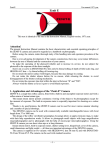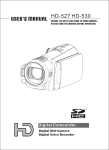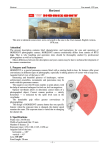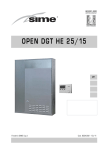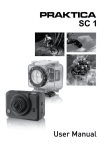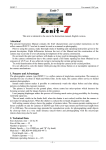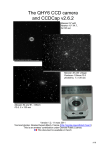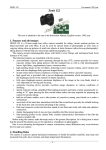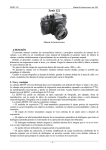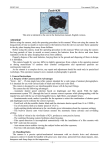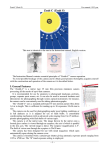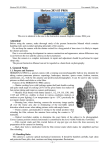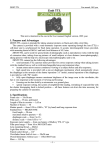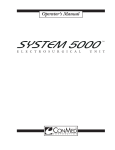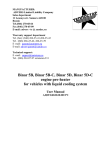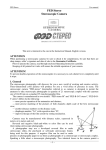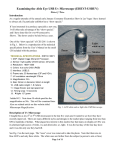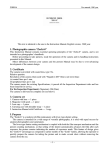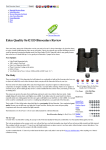Download Zenit PhotoSniper
Transcript
Zenit PhotoSniper User manual, 1992 year Zenit PhotoSniper This text is identical to the one in the Instruction manual, English version. Attention! The present Instruction Manual contains brief characteristics and essential rules of using the PHOTOSNIPER photogun. Before using the photogun, make thorough study of the handling rules according to the present Manual to master correct procedures. Minor differences between the Description and your photogun may be due to ever-advancing development of the camera and design. To ensure long period and trouble/free operation of the camera the following should be kept in mind: Do not touch the surfaces of the optics with hands as it is likely to cause damage of the coating. Do not turn the release button, if not necessary, while releasing the shutter to avoid the cutting out of the shutter setting mechanism. Do not rotate the shutter speed dial in the interval between “B” and “500”. While cocking the camera shutter, always turn the setting lever up to the mechanical limit to avoid blank frames on the film. Check the work of the shutter before loading the camera. To do this turn the shutter cocking lever with one or more movements up to the mechanical limit. Then press the release button. 1. Application and Advantages The PHOTOSNIPER photogun in a combination of a special TAIR-3-PhS long focus lens and ZENITES reflex camera. The lens with the camera is mounted on a gun stock with a grip fitted with a release mechanism. The photogun is designed for taking close-up picture of animals, birds and plants under natural conditions. The photogun can be successfully used for sports photograph as well as for taking close-up pictures of distant architectural details. The ZENIT-ES camera has many attractive features including an instant return mirror, providing continuous watching of the subject to be photographed (except for the moment of exposure), built-in exposure meter (particularly valuable when photographing on a colour film), shutter setting lever and hinged back cover. In the photograph of 13×18 cm size (5 times magnification of the negative picture size) one can distinguish the details that can be clearly seen through the field glass. The size of the details distinguishable in the picture equals approximately to 1/10000 of the taking distance. The ZENIT-ES type camera of the photogun is fitted with a built-in uncoupled exposure meter and an instant return mirror. Unlike the ZENIT-E camera, it has an additional release button at the bottom of the camera body (coupling the camera with the grip trigger), more remote exit pupil of the viewfinder eyepiece (for comfortable shooting) and 42×1 mm thread that makes possible to use lenses from the Praktica, Asahi, Pentax, Pentacon, Edixa, etc. cameras as interchangeable ones. Using the reflex viewfinder (ground glass focusing) and extension rings, one can do reproduction –1– Zenit PhotoSniper User manual, 1992 year works, take pictures with large magnification (macrophotography) and photograph with the aid of a microscope (microphotography). The standard long focus TAIR-3-PhS lens has an automatic spring-loaded (“jumping”) pre-set diaphragm closing down to the pre-set position at the moment of shooting (when pressing the release trigger of the grip). The lens is fitted with a quick focusing device which enables to focus the lens continuously without removing the left hand from the gun stock and to set the diaphragm and release the shutter by pressing the release trigger, when required. The optical surface of the TAIR-3-PhS lens have an “amber” coating, which ensures correct colour rendition when photographing on a colour film. 2. Main Units and Details 1. Sun shade 2. Diaphragm setting knob 3. Diaphragm ring 4. Aperture indicating mark 5. Ring for camera attachment 6. ZENIT-ES camera 7. Indicating mark of distance scale 8. Lens focusing drum 9. Bracket 10. Guide pins 11. Diaphragm release lever 12. Release pushing screw 13. Adjusting screw for diaphragm advance 14. Supporting ring 15. Clamping screw 16. Tripod screw 17. Release trigger 18. Shoulder butt clamp 19. Diaphragm setting ring index 20. Diaphragm ring with index 21. Distance scale 22. Diaphragm setting ring 23. Deph of field scale with index 24. Focusing ring 25. Lens attachment ring –2– Zenit PhotoSniper User manual, 1992 year 26. Shoulder butt 27. Cover, front 28. Light filters 29. Cover, back 30. Self-timer setting lever 31. Self-timer release button 32. Flash unit connector socket 33. Film rewind release button 34. Exposure time scale 35. Detachable bracket for flash lamp 36. Photocell –3– Zenit PhotoSniper User manual, 1992 year 37. Cassette chamber 38. Cassette spool guide 39. Viewfinder eyepiece 40. Eye hood 41. Take-up spool 42. Camera swing back 43. Film pressure plate 44. Lock latch 45. Take-up spool spring 46. Sprocket 47. Film channel slides 48. Shutter release button 49. Film gate 50. Guide of calculator diaphragm scale 51. Exposure time scale of calculator 52. Film speed scale 53. Film speed scale index 54. Diaphragm scale of calculator 55. Film rewind knob 56. Exposure time scale 57. Indicating mark of exposure time scale 58. Shutter release button 59. Exposure counter dial 60. Guide of exposure counter dial 61. Index of exposure counter dial 62. Shutter setting lever 63. Synchronization setting lever 64. Synchronization lever index 65. Exposure meter needle 66. Calculator pointer –4– Zenit PhotoSniper User manual, 1992 year 3. Specifications Frame size, mm . . . . . . . . . . . . . . . . . . . . . . . . Width of perforated film, mm . . . . . . . . . . . . . Number of frames . . . . . . . . . . . . . . . . . . . . . . Shutter speed . . . . . . . . . . . . . . . . . . . . . . . . . . Viewfinder field of view, mm . . . . . . . . . . . . Eyepiece magnification . . . . . . . . . . . . . . . . . 24×36 35 36 from 1/30 to 1/500 sec (automatic), “B” (by hand) and long exposure time 20×28 4,5x LENSES Focal length, mm . . . . . . . . . . . . . . . . . . . . . . Relative aperture . . . . . . . . . . . . . . . . . . . . . . . Mechanical back focal distance (the axial distance between the film plane and the plane of the seating scoulder), mm . . . . . . . . . . . . . . Seating thread of the lens . . . . . . . . . . . . . . . . Minimum taking distance, m . . . . . . . . . . . . . Diaphragm scale . . . . . . . . . . . . . . . . . . . . . . . Sun shade seating shoulder . . . . . . . . . . . . . . . Light filter mounting thread . . . . . . . . . . . . . . Tripod socket thread of the TAIR-3-PhS lens and the ZENIT-ES camera . . . . . . . . . . . . . . . TAIR-3-PhS 300 f/4,5 HELIOS-44-2 58 f/2 45,5 42×1 3 4,5 to 22 72×0,75 72×0,75 45,5 42×1 0,5 2 to 16 ø55 mm 49×0,75 3/8ʺ OVERALL DIMENSIONS Of the photogun ready to use, mm . . . . . . . . . Of the photogun case, mm . . . . . . . . . . . . . . . 140×235×560 170×210×360 WEIGHT Of the photogun ready to use, kg . . . . . . . . . . Of the photogun colpete set in the case, kg . . 2,9 5,5 4. Preparation for Photographing 4.1. Preparation of the Photogun for Photographing 1. Open the case. 2. Release the tripod screw of the gun stock and remove the stock from the case. 3. Holding the lens body with the left hand, screw out the clamping screw which fastens the lens with the camera to the bracket of the case; then remove the lens from the case. 4. Carefully join the stock to the lens. To do this put two guide pins of the stock into sockets of the lens bracket and the release button bush – into the hole of the supporting ring. 5. Tightly fasten the stock to the lens with the tripod screw. 6. Slightly tighten the clamping screw. 7. Put the shoulder butt in the socket of the stock and fasten it with a clamp. 4.2. Loading the Camera The camera is loaded at usual lighting in the following order: 1. Cut straight the end of the film. Open the back cover of the camera. 2. Insert the cut end of the film under the take-up spool spring, and see that a sprocket tooth engage a sprocket hole. See that the film is placed correctly between the film channel slides. –5– Zenit PhotoSniper User manual, 1992 year 3. Place the cassette into the cassette chamber. Before doing this, pull the film rewind knob upwards. 4. Return the film rewind knob into its initial position and fix in this position by turning it in the arrow direction. 5. Close the back cover and press down the lock latch. 6. Cock the shutter, turning the shutter setting lever to the stop; then press the release button. The shutter being cocked, the film moves one frame. To transport non-exposed film to the film gate, cock the shutter three times each time pressing the release button. When setting the shutter see to it that the film rewind knob rotate. If not, check whether the camera is correctly loaded with film. 7. Turning the exposure counter dial set figure “0” against the indicating mark. Set the exposure counter dial with the shutter cocked. 4.3. Setting the Film Sensitivity The film sensitivity dial is marked with figures 16, 32, 65, 130, 250, 500 indicating film sensitivity in ГОСТ-ASA units on one side and with figures 13, 16, 19, 22, 25, 25 indicating film speed in DIN grades on the opposite side. There are two dots under figure 32: the left one corresponds to the film sensitivity of 25 ГОСТ-ASA units and the right one – to that of 32 ГОСТ-ASA units. Figures of the film sensitivity dial are seen in the windows of the diaphragm scale. The windows are provided with setting indexes. To set a film speed (for example 65 ГОСТ-ASA units) turn the diaphragm scale until the setting index matches with scale division 65. The same procedure should be performed in setting film sensitivity if the film is marked in DIN grades. 4.4. Exposure Determining Aim the photogun at the object to be photographed. Turning the exposure time scale to the right or to the left, match the exposure meter needle with the centre of the calculator pointer. (The needles can be observed in the window at the top of the camera). In this case the hatches of the exposure time scale and the diaphragm scale should coincide. The hatches are allowed not to coincide within ½ of interval between the hatches. With the needles matched figures on the scales allow to set a number of combinations of exposure times and diaphragms for some definite illumination and film sensitivity. With any of these combinations the negative obtained will be of normal density. Keep in mind that figures on the diaphragm scale indicate relative aperture values; figures from 500 to 2 on the exposure time scale show exposure time values in fractions of a second and those from 1 to 30 show whole seconds. Black figures on the calculator diaphragm scale correspond to figures engraved on the exposure time dial. The exposure time and the diaphragm value chosen depending on conditions of photographing should be set on the camera and the lens. Note. Exposure meter shows correct exposure in case of photographing with the lens, angular field of which is large enough, i.e. is near to the angular field of the photocell (for instance, the HELIOS-442 lens with angular field of 40°). When photographing with the TAIR-3-PhS lens (angular field of 8°) correct results are obtained if brightness of the object being photographed within 40–50° only slightly differs from that of the background. 4.5. Exposure Time Setting Lifting up the exposure time dial and turning it round its axis set the selected exposure time value –6– Zenit PhotoSniper User manual, 1992 year against the index mark in the middle of the dial. Figures on the exposure time dial indicate fractions of a second; “B” indicates handcontrolled exposure time. To obtain long exposure tome cock the shutter, set the exposure time dial at “B”, press the release button and turn it counterclockwise as far as it goes. After exposure return the button into initial position. Notes: 1. Exposure time may be set both with the shutter cocked and released. 2. It is good practice to use a tripod when photographing at long exposure time and “B”. 3. When photographing without flash lamps, the synchronization lever may be set in any position. COMPARATIVE TABLE OF FILM SENSIBILITY UNITS OF ГОСТ, ASA and DIN ГОСТ-ASA 16 20 25 32 40 50 65 80 100 130 160 200 250 320 400 500 DIN 13 14 15 16 17 18 19 20 21 22 23 24 25 26 27 28 4.6. Diaphragm Setting 4.6.1. Of the “TAIR-3-PhS” lens 1. Lay your left palm on the lens body and turn the diaphragm knob with the thumb to the stop in the arrow direction. 2. Turning the diaphragm setting ring, set one of the figures (4.5; 5.6; 8; 11; 16; 22) corresponding to the selected diaphragm against the index mark. Each of these positions is fixed with a click stop. 4.6.2. Of the “HELIOS-44-2” lens Set one of the figures (2; 2.8; 4; 5.6; 11, 16) engraved on the diaphragm setting ring against the index mark (dot). The ring should be turned up to a click stop. f/ D (m) 3 3.5 4 5 6 8 10 15 20 40 80 ∞ DEPTH-OF-FIELD TABLE FOR THE “TAIR-3-PhS” LENS (f = 300 mm) 4.5 5.6 8 11 16 from – to from – to from – to from – to from – to 2.99 – 3.01 3.48 – 3.52 3.97 – 4.03 4.95 – 5.05 5.93 – 6.07 7.87 – 8.14 9.79 – 10.22 14.50 – 15.53 19.11 – 20.98 36.48 – 44.30 66.84 – 99.60 400 – ∞ 2.98 – 3.02 3.48 – 3.52 3.97 – 4.04 4.94 – 5.06 5.91 – 6.09 7.84 – 8.17 9.74 – 10.28 14.39 – 15.67 18.90 – 21.24 35.71 – 45.49 64.26 – 105.97 322 – ∞ 2.98 – 3.02 3.47 – 3.54 3.95 – 4.05 4.92 – 5.08 5.88 – 6.13 7.77 – 8.25 9.63 – 10.40 14.14 – 15.98 18.47 – 21.82 34.14 – 48.35 59.29 – 123.19 225 – ∞ 2.97 – 3.03 3.45 – 3.55 3.93 – 4.07 4.89 – 5.12 5.83 – 6.18 7.69 – 8.34 9.50 – 10.56 13.85 – 16.38 17.96 – 22.59 32.37 – 52.47 54.07 – 154.66 164 – ∞ 2.96 – 3.05 3.43 – 3.57 3.91 – 4.10 4.84 – 5.17 5.76 – 6.26 7.55 – 8.51 9.29 – 10.85 13.38 – 17.10 17.16 – 24.02 29.81 – 61.18 47.16 – 269.92 113 – ∞ 22 from – to 2.94 – 3.07 3.41 – 3.60 3.87 – 4.14 4.78 – 5.24 5.68 – 6.37 7.40 – 8.72 9.05 – 11.20 12.86 – 18.05 16.30 – 25.99 27.22 – 76.49 40.92 – ∞ 82 – ∞ Notes: 1. D – distance in metres – distance from the film plane to the object. 2. In depth of field calculation the circle of confusion was accepted to be equal to 0,05 mm. –7– Zenit PhotoSniper User manual, 1992 year 4.7. FOCUSING THE LENS FOR IMAGE SHARPNESS 4.7.1. “TAIR-3-PhS” lens 1. Turning the diaphragm setting knob until it goes, open the diaphragm. 2. Acting like a rifle-man, observe the aim through the viewfinder eyepiece. To obtain sharp image of the object on the ground glass of the viewfinder rotate the lens focusing drum with your left hand. If you want to photograph a group of objects unequally spaced from the camera, use should be made of the depth-of-field table. Required diaphragm should be selected according to this table. For example: with the lens set at 40 m and diaphragm of f/11 objects spaced within 32 to 52 will be sharp on the film. 4.7.2. “HELIOS-44-2” lens 1. Open the diaphragm turning the diaphragm ring counter-clockwise as far as it goes. 2. Aim the camera at the object to be photographed and, observing through the viewfinder eyepiece, turn the lens focusing ring until sharp image of the object is obtained on the ground glass screen. 3. Close the diaphragm to the pre-set position by turning the diaphragm ring clockwise as far as it will go. With different combination of distance and diaphragm values the depth-of-field limits are determined with the help of the depth-of-field scale made on the HELIOS-44-2 lens. The depth-of-field scale consists of number pairs symmetrically spaced on both sides from the indicating mark. Each number pair corresponds to a definite diaphragm opening. After focusing two values on distance scale can be read against such a pair of numbers. These distance values indicate the depth-of-field limits. For instance, with the lens focused at 4 m and an aperture of f/11 the image of objects placed within the range of 2.5 to 10 m will be sufficiently sharp on the film. 5. Photographing 5.1. Photographing with the “Photosniper” Photogun 1. Prepare the photogun for picture taking. 2. Select a light filter according to the type of film, conditions of photography and the scene, and screw it into the the lens mount. 3. Screw the sun shade into the light filter or the lens mount. 4. Load the camera. 5. Set the film sensitivity value on the film sensitivity scale of the camera. 6. Determine exposure time and aperture value and set the values on the exposure time dial and the lens diaphragm ring. 7. Acting like a rifle-man, look through the viewfinder eyepiece and aim the camera at the object to be photographed. Focus the lens by rotating the focusing drum and then smoothly, without jerks press the gun trigger. To prepare the photogun for taking the next picture turn the diaphragm setting knob and the shutter setting lever with your left hand. At the same time support the photogun with your right hand to keep it ready for use. When the long-focus TAIR-3-PhS is used with small apertures, a slight vignetting of the image edges is possible, which is practically of no importance. A. With “TAIR-3-PhS” lens at long exposure times To photograph with the TAIR-3-PhS lens at exposure times longer then 1/60 sec (for instance, 1/30 or 10 sec) the photogun should be set on a tripod; otherwise the obtained picture may happen to be unsharp. To work with the camera mounted on a tripod act as follows: 1. Remove the lens with the camera from the case. Having loaded the camera, mount it on the tripod using threaded socket of the bracket. –8– Zenit PhotoSniper User manual, 1992 year 2. Open the diaphragm by moving the knob in the arrow direction as far as it will go. 3. Set the required aperture. 4. Set the exposure time on the camera dial. 5. Aim the photogun at the object to be photographed. 6. Focus the lens. 7. Holding the lens body carefully press the diaphragm release lever from below. 8. Cock th shutter. 9. Press the release button at the top of the camera. B. With “HELIOS-44-2” lens 1. Open the case and, holding the lens body with your left hand, loosen the clamping screw and remove the lens with the camera out of the case. 2. Carefully unscrew the TAIR-3-PhS lens out of the camera and immediately cover the thread with a back cover having taken it from a ring in the case. 3. Place the lens in the case and fasten it with the clamping screw. 4. Having removed a hermetic cap, unscrew the HELIOS-44-2 lens out of the seating socket on the inner side of the case cover and mount it on the ZENIT-ES camera. 5. Load the camera with film. 6. Set the film sensitivity. 7. Using the exposure meter, determine exposure time and diaphragm and set these values on the camera and the lens. 8. Open the diaphragm by turning the diaphragm setting ring counter-clockwise as far as it will go. 9. Looking through the viewfinder eyepiece aim the camera at the object to be photographed. Turning the focusing ring, focus the lens. 10. Close the diaphragm to the pre-set value by turning the diaphragm ring clockwise as far as it will go. 11. Keeping the object being photographed in the viewfinder frame, smoothly, without jerks, press the release button. C. With flash bulbs For photographing in poor illumination use should be made of flash bulbs or electronic flash. For this aim the ZENIT-ES is fitted with a special device which synchronizes the bulb flash moment with the shutter operating time. To switch on a single action flash bulb the synchronization setting lever should be set at “MF”. When operating with an electronic flash kit, set the synchronization setting lever at index “X”. Only exposure time of 1/30 (i.e. when the shutter is completely open) may be used in the ZENIT-ES camera if photographing with either flash bulbs or electronic flash. Photographing with flash bulbs at “B” exposure time is not advisable since a considerable amount of stray light (after flash) gets into the camera resulting in a blurred image on the film. D. With self-timer To photograph with self-timer, do the following procedure: mount the photogun on a tripod or fix it in any other way; cock the shutter; wind the self-timer mechanism by turning the self-timer setting lever downwards as far as it will go; set the exposure time; choose the frame; focus the lens by a definite place of the frame; close the diaphragm to the stop and, having pressed the self-timer release button, take your place before the camera. The shutter operates in no less then 9–20 sec after pressing the button. 5.2. Camera Unloading When the exposure counter dial shows figure 36 it means that the exposed film should be rewound into the cassette. –9– Zenit PhotoSniper User manual, 1992 year The procedure is the following: 1. Press the film rewind knob and turn it contrary to the arrow direction. 2. Disengage the shutter mechanism by pressing the film rewind button. Keeping the button in this position, rotate the film rewind knob in the arrow direction until you feel by the applied force that the film end is pulled out from under the take-up spool spring. 3. Open the back cover of the camera. 4. Pull the film rewind knob upwards and remove the cassette out of the camera. 6. Accessories; Care of the Camera 67. Shoulder strap for photogun 68. Cap 69. Interchangeable lens (with cap) 70. Cover, front 71. Light filters 72. Cover, back 73. Screw-drivers 74. Cassettes 75. Shoulder sraps for case 76. Clamping screw 6.1. Case with Accessories The photogun with accessories is packed un in a stamped aluminium case where it is securely protected in any route conditions. The TAIR-3-PhS lens with the ZENIT-ES photographic camera is fastened to a bracket with a tripod screw. Spring clamps secure the shoulder butt at the bottom of the case. The inner side of the case cover carries: the HELIOS-44-2 lens under a hermetic cap; five light filters; two cassettes; two screw-drivers; two covers (front and back). The case has sturdy locking catches, preventing accidental opening, a carrying grip and shoulder or on the back (like a knapsack) in route conditions. The straps have buckles intended for varing the straps length. The complete set includes a rubber sunshade which is screwed on the TAIR-3-PhS lens (like the light filters). It is used to protect the lens from undesirable side-light. Besides that, it protects the lens and light filters against damage when photographing under complicated conditions. – 10 – Zenit PhotoSniper User manual, 1992 year 6.2. Accessories 6.2.1. Light filters The complete photogun set includes five light filters: Yellow filter Y-2x is widely used in landscape photography;improves right colour condition of blue, green and yellow objects; emphasizes clouds and increases contrast of shadows and remote objects; eliminates the effect of atmospheric haze. Colourless filter UV-1x eliminates the influence of ultraviolet rays (for instance, in high-mountain conditions) in black-and-white and especially in colour photography. Light yellow filter Y-1.4x improves rendition of visual brightness correlations of blue, green and yellow objects in portraiture with natural illumination, in photographing landscapes under clouded blue sky and the evening illumination when operating at brief exposure times. Orange filter O-2.8x is used in taking pictures of remote objects when it is necessary to reduce the effect of atmospheric haze; it increases the contrast of such objects. In usual photography the sky in the photograph is very dark and clouds are bold. Yellow-green filter YG-2x is of especial value for correct colour rendition (in particular, of red and green colours) on panchromatic films. The filter is used in portraiture both by day and artificial light, in artistic and technical photography of paintings and colour pictures. FILTER FACTOR TABLE (by day light) Light filters Films UV-1x Y-1.4x Y-2x O-2.8x YG-2x Filter factor Isopanchromatic 1 1.5 1.5-2 2.5 1.5 Panchromatic 1 1.5 1.5-2 2.5 4 Note. Filter factor is the ratio of the exposure time used when photographing with a light filter to the one required when photographing without a light filter (illuminating conditions are the same). 6.2.2. Cassettes The camera set comprises three film cassettes. One cassette is placed in the camera and two others are fastened on the case cover. 6.2.3. Screw-drivers Sometimes, when “hunting” with the photogun, simple adjustment can be needed. To this end the camera set comprises two screw-drivers (4 mm and 1.7 mm) attached to the case cover. 7. Care of the Camera The photogun should be handled carefully, should be kept clean and protect from mechanical damages, moisture and sharp temperature fluctuations. Keep the photogun in a closed case. In such cases the diaphragm of the TAIR-3-PhS lens should be set at “22”, the diaphragm setting knob, the shutter and the self-timer be released. Never remove the lens from the camera (unless you need it) to prevent dust and dirt from getting on the surface of optical parts. Clean the optical coated lens surfaces only from outside with a clean soft piece of fabric or cotton, slightly moistened with rectified alcohol, ether (petroleum or sulfuric) or, if these means are absent, with toilet eau-de-Cologne. As the photogun is a complex optical mechanical device, any repair of the camera and its adjustment should be performed by a highly qualified specialist. http://eugigufo.net/en/download/photovideo/ – 11 –











